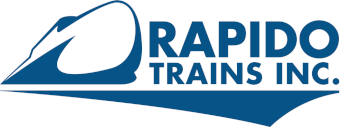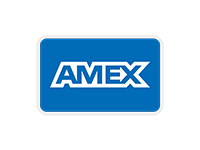EMD’s Early SDs Masterclass
EMD’s Early SDs
By Craig Walker

EMD Goes Long – Introducing the SD7
General Motors’ Electro-Motive Division (EMD) introduced its 4-axle GP7 General Purpose road switcher in October 1949, and sales were terrific. Thanks to requests from railroads, EMD’s engineering staff began work on a longer six-axle version, the SD7, with the additional two axles with traction motors providing more tractive effort as well as improved weight distribution, a Special Duty diesel-electric locomotive ideal for use in heavy duty, low-speed service. As with the earlier GP7s, these were built with high short hoods and they were intended to be operated long-hood forward, although many were later modified to operate short hood forward. The diesels utilized EMD’s V-16 567 diesel engine (the 567B for the two demonstrators, then the V-16 567BC or 567C diesel prime movers under the hood on production locomotives) generating 1500 horsepower (1.12 MW). SD7s were 61 feet 2¾ inches (18.66 m) long, whereas the GP7s were 55-feet 11-inches (17.04 m) in length. While preferred by many railroads, the SD7’s production of 188 locomotives between May 1951 and November 1953 paled in comparison with the GP7’s 2729 units. All SD7s were purchased by American railroads.
Stylistically similar the GP7, the SD7 was (as already mentioned) longer and rode on a pair of three-axle three-motor Flexicoil C trucks.
As with other locomotives of the day, SD7s were built with, or without, dynamic braking. As usual with EMD hood diesels, this variation was plainly visible due to the dynamic brake’s blister atop the long-hood and two additional fans on the top of that.
The SD7 had all four of its radiators in a single group at the end of the long-hood, rather than split as on the GP7s, with the SD7’s radiators protruding a bit from the hood sides.
SD7 diesels have their classification lights centered over each of their four numberboards, and mounted on an access door.
All SD7s were built with high short-hoods.
As EMD progressed at a rapid pace with new locomotive technology in the 1960s and 1970s, SD7s fell out of favor with a lot of Class I railroads as higher horsepower diesels were purchased: SD18s, SD24s, SD38s, SD39s, SD40s, SD45s and more. These railroads got a lot of use out of their SD7s, and they were then sold to secondary owners, for whom they rolled down many more miles hauling freight for their new owners. Difficult to find in service in the twenty-first century, there are a number of SD7 preserved in museums around the United States.
Unsurprisingly, many SD7s got modified over the years, with modifications ranging from altering them to operate short-hood forward to lowering the short-hood (thus making the short-hood short!)
The initial SD7 owners were:
- Baltimore & Ohio – 761-764 (4 locomotives)
- Bessemer & Lake Erie – 451-455, 801-803 (8 locomotives)
- Central of Georgia – 201 (1 locomotive)
- Chicago & North Western – 1660-1664 (8 locomotives)
- Chicago Burlington & Quincy – 300-324, 400-411 (37 locomotives)
- Chicago, Milwaukee, St. Paul & Pacific – 2200-2223 (24 locomotives)
- Colorado & Southern (CB&Q subsidiary) – 810-819 (10 locomotives)
- Denver & Rio Grande Western – 5300-5304 (5 locomotives)
- Electro-Motive Division – Demonstrators 990-991 (EMDX 990 to SP 5308/SP 2715/SP 1415/SP 1518; EMDX 991 to B&O 760)
- Fort Worth & Western (CB&Q subsidiary) – 850-860 (11 locomotives)
- Great Northern – 550-572 (23 locomotives)
- Kennecott Copper Corp. – 903 (1 locomotive)
- Minneapolis & St. Louis – 852, 952 (2 locomotives)
- Nevada Northern – 401 (1 locomotive)
- Pennsylvania Railroad – 8588-8589 (2 locomotives)
- Southern Pacific – 5279-5293, 5309-5335 (42 locomotives)
- Union Pacific – 775-784 (10 locomotives)
Many of these railroads renumbered their SD7s (such as MILW, M&STL and SP) at least once during their tenure.
Subsequent SD7 owners include those acquired through mergers, such as Burlington Northern (CB&Q, C&S, FW&D, GN), Chicago & North Western (M&STL) and Penn Central (PRR) and Conrail (PC).
Others were sold and rebuilt, such as UP’s going to Illinois Central Gulf and becoming SD20s.
Variations … There Are Always Variations
As with so many locomotives, there were a number of variations, often due to their owners’ preferences, such as lighting options, bells, air horns, plows, etc.
Here is a list of many of these options and variations:
- Many railroads ordered their SD7s with other options, such as signal lights, snowplows, air horns styles, bells (type and placement), radio antennas and other equipment. Checking photos is advisable.
- SD7s were built with either one or two fuel tanks. The single tank version may have been available for those railroads requiring a lighter weight locomotive.
- A few SD7s were built with steam generators in their short-hoods for passenger service. Passenger SD7s had two tanks, one for fuel and the other for steam generator water.
-
SD7s featured corner stepwells that resembled those in switchers, in that the steps themselves were flush, with the exception of the lowest step. This allowed crew members to stand in the stepwell comfortably and safely when switching cars.
- However, Great Northern’s SD7s were built with one addition step in the stepwell, for a total of 5 rather than 4 steps.
-
While access doors on the sidesills, which allowed access to piping and conduit placed below the frame on later diesels, were uniform when built, with louvers on one side and plain covers on the other (and, because the fronts of these locomotives depended upon the owners’ needs, refer to photos), over the years these tended to get switched around over the years.
- EMD demonstrator 990, later Southern Pacific 5308/2715/1415, featured doors with holes rather than louvers.
-
A few SD7s were built with dual control stands in order to operate them in either direction without having to turn them.
-
Many, but not all, SD7s were built with poling pockets adjacent to their stepwells.
-
B&LE SD7s had a sand fill door on the hood ends, rather than on the top of the hoods.
-
Some Southern Pacific SD7s were rebuilt into SD7Rs in 1979 and 1980. As these were not intended for service on mountainous divisions, the dynamic brakes were removed and the fan locations plated over, although the blisters remained in place. Also, a new shield with the same contour as the cab roof was added to the long-hood behind the cab.
-
Most SD7s were built with dynamic brakes, but some were built without them, such as B&O 761-764, B&LE 451-455, CB&Q 400-411, CG 201, GN 550-572 and NN 401.
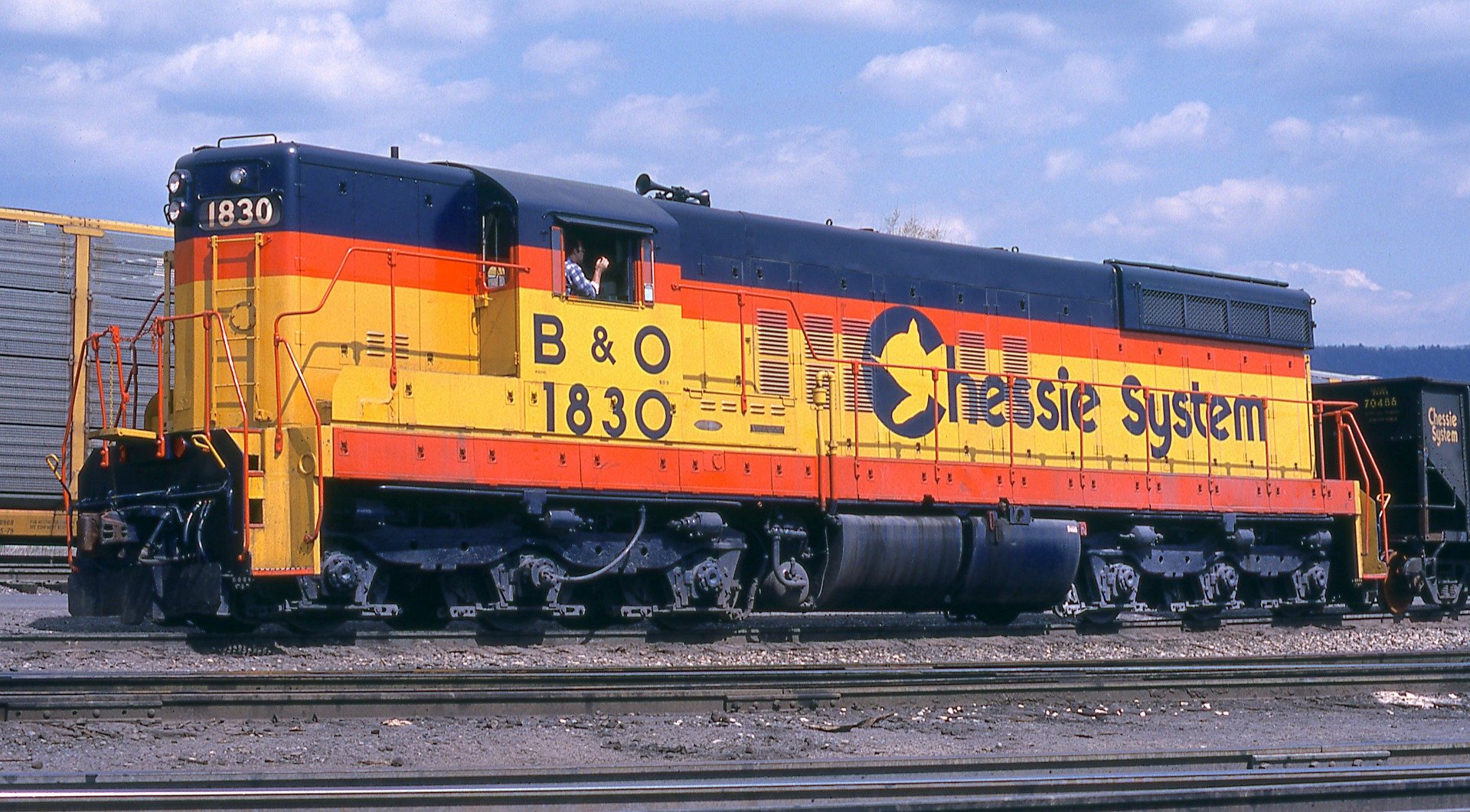
Baltimore & Ohio SD7 1830, painted in the later Chessie System markings, is a fairly “stock” SD7: It operates long-hood forward, has no dynamic brakes, the class lights are centered over the numberboards, it features poling pockets and the stepwells are the “switcher” design to allow a crewman to stand on the lowest step safely. IT does, however, feature two tanks between the trucks, rather than just one. This locomotive was photographed in Cumberland, Maryland, on April 22, 1983.
Doug Boyd photograph, Warren Calloway collection

Southern Pacific SD7 1421 (ex-SP 2721, originally-SP 5314 ... and later to be SP SD7R 1508) is an example of an SD7 with a single fuel tank and no water tank. It also sports the large “ash can” signal lights found on many of SP’s early EMD 6-axle power (and some end cab switchers as well). The louvers to allow cooing under this side of the walkway are clearly evident in this view. SP 1421 was photographed in they idyllic City of Industry, a real garden spot (provided you don’t like vegetation) several miles east of downtown Los Angeles, California, on January 22, 1977.
Ron Hawkins photograph
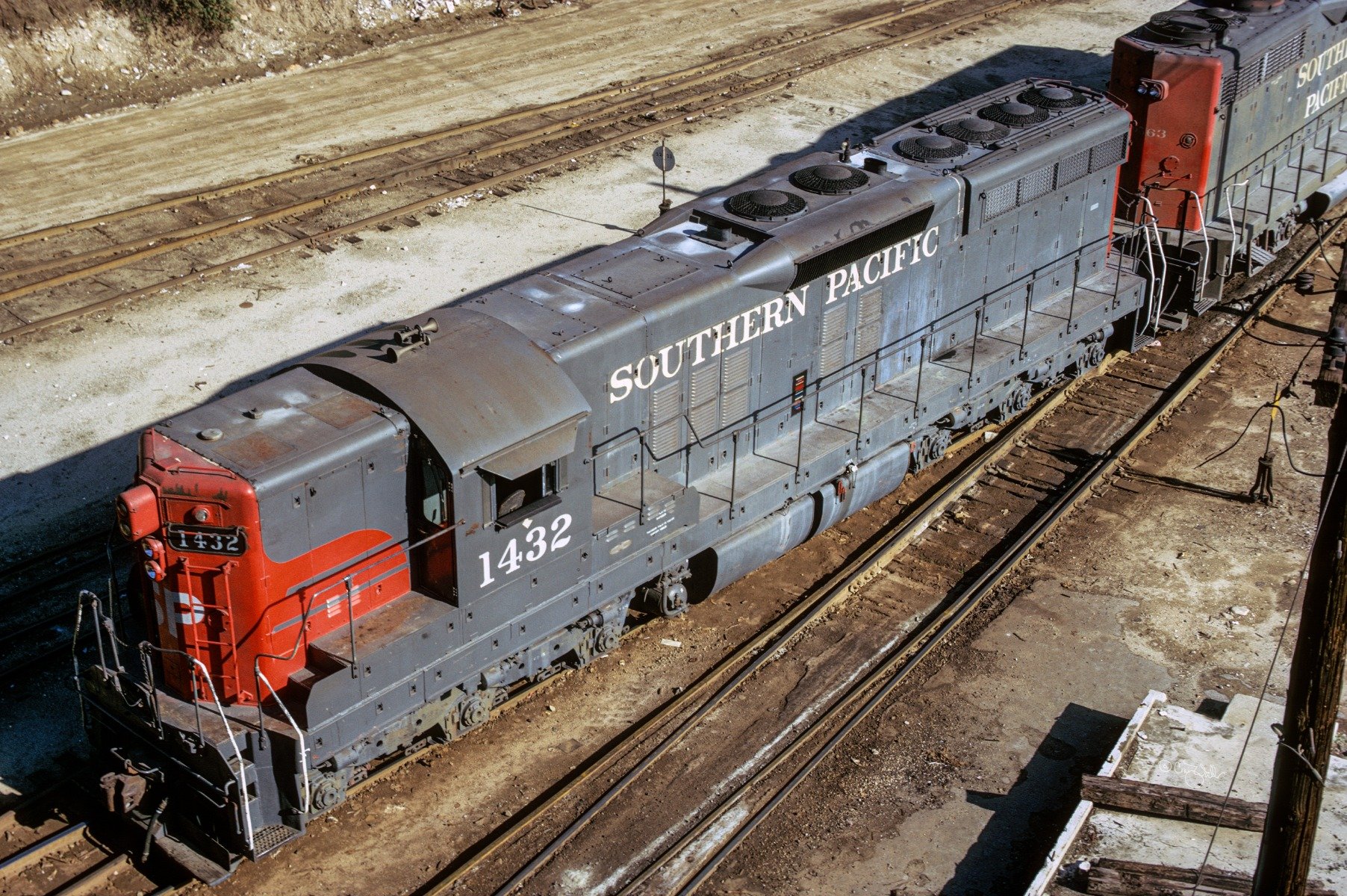
In this overhead view of Southern Pacific SD7 1432 (ex-SP 2732, née-SP 5325 ... and eventually SP SD7R 1524) we can see where the old steam generator stack and vent were located, now marked by rusty square plates on the roof of the short-hood, adjacent to the round toilet vent and the radio antenna base. And these removed steam generator apparatuses indicate that SP 1432 was originally a passenger locomotive, hence the fuel tank and water tank. (That water tank was later converted into second fuel tank.) We also get a good view of the “switcher style” stepwells, illustrating how advantageous they were for switchmen to ride upon. Note, too, the more complex handrail arrangement in the stepwell area, in which a T-joint splits the railing – a design simplified on later EMD locomotives. All of Southern Pacific’s SD7s were operated short-hood forward and thus adorned with the scarlet “wings” on that end of the locomotive. SP’s SD7s (and SD9s) featured a variety of signal lights on their ends, and SP 1432 was equipped with a Pyle-National Gyralight on its ends, above the headlights. Note, too, the cooling piping around the radiator fans, the two dynamic brake fans, the two exhaust stacks and a lack of poling pockets. (Los Angeles, California – March 31, 1974)
Craig Walker photograph
But Wait … There’s More!
Following the production of SD7s, EMD created the next Special Duty diesel-electric locomotive: The SD9. Produced in EMD’s La Grange, Illinois, plant from January 1954 through June 1959, the SD9 utilized a 16-cylider EMD 567C diesel engine generating 1,750 horsepower (1.30 MW), powering the locomotive’s six traction motors (one per axle) – an improvement over the SD7. The 567C was also easier for shop forces to maintain, always a selling point to customers (i.e., railroads).
While the 188 SD7s were a modest success, the later SD9s were a greater success, with a total of 471 sold to America’s railroads and industries, and an additional 44 exported to other countries.
Externally, the SD9 looks very similar to its predecessor, the SD7, in much the same way the earlier GP7 and GP9 look alike. One of the primary spotting features is the location of the class lights on the ends of the hoods, above the numberboards – They are centered above the numberboards on the SD7, but located outward, toward the sides of the locomotive and canted outward, on the SD9.
As with the earlier SD7, all SD9s were built with high short hoods (commonly referred to as the “nose,” although that becomes confusing if the locomotive is set up to operate long-hood forward, so it is more accurate to call it a short hood, even though it is tall. Confused? Then our work here is done…) And, as with the SD7s, over time many SD9s had their short hoods lowered … or chopped.
Most SD9s featured four 36” radiator fans on the roof of the long-hood, as found on the SD7s, but on the last phase of construction a pair of 48” fans were utilized, and the rooftop piping was gone. This change would be carried over to the later SD18 and SD24 locomotives as well.
SD9 original purchasers were:
-
Atlanta & St. Andrews Bay – 503-505 (3 locomotives)
-
Baltimore & Ohio – 765-774 (10 locomotives)
-
Central of Georgia – 202-207 (6 locomotives)
-
Chicago & Illinois Midland – 50-54 (5 locomotives)
-
Chicago & North Western – 1701-1710, 1721-1724 (14 locomotives)
-
Chicago Burlington & Quincy – 325-374, 430-459 (80 locomotives)
-
Chicago, Milwaukee, St. Paul & Pacific – 2224-2237 (14 locomotives)
-
Chile Exploration (Chile) – 901-905 (5 export locomotives)
-
Colorado & Southern (CB&Q subsidiary) – 820-842 (23 locomotives)
-
Denver & Rio Grande Western – 5305-5314 (10 locomotives)
- Duluth Missabe & Iron Range – 101-10-, 111-174 (73 locomotives)
-
Electro-Motive Division – Demonstrator 5591 (EMDX 5591 was sold to DM&IR as 110)
-
Elgin Joliet & Eastern – 600-602 (3 locomotives)
-
Great Northern – 573-599 (27 locomotives)
-
Korail (Korea) – 101-129 (29 export locomotives)
-
New York Chicago & St. Louis (Nickel Plate Road) – 340-359 (20 locomotives)
-
Orinoco Mining (Venezuela) – 1011-1020 (10 export locomotives)
-
Pennsylvania Railroad – 7600-7624 (25 locomotives)
-
Reserve Mining – 1220-1225 (6 locomotives)
-
Soo Line (Wisconsin Central) – 2381 (1 locomotive)
-
Southern Pacific – 5340-5444, 5449-5493 (150 locomotives)
Many of these railroads renumbered their SD9s (such as B&O, C&NW, MILW and SP).
Subsequent SD9 owners include those acquired through mergers, such as Burlington Northern (CB&Q, C&S), Norfolk & Western (NKP), Norfolk Southern (N&W), Penn Central (PRR) and Conrail (PC).
Once Again … There Were Variations!
With this many locomotives spread over eighteen American owners, there were variations.
As usual, these variations were often due to their owners’ preferences, such as plows, lighting options, bells, air horns, etc. All SD9s were built with high short-hoods.
There were four phases of SD9s:
- Phase I
- Four 36” radiator fans with piping on either side
- Pipe style handrail stanchions (as on the SD7)
- Tiered stepwells (as on the SD7)
- “Frog Eye” class lights mounted above the outer end of the numberboards
- Phase II
- Four 36” radiator fans with piping on either side
- Formed steel handrail stanchions
- A single ladder of the engineer’s side of the short-hood
- Phase III
- Two 48” radiator fans, with no piping on the roof
- Phase IV
- Two 48” radiator fans, with no piping on the roof
- Cab and short-hood are notably taller due to a larger battery box on the fireman’s side of the locomotive
- Top edge of the long-hood behind cab is squared off, rather than rounded off, for a few feet
- Grabirons, rather than a ladder, mounted on the engineer’s side of the end of the short-hood
- Late phase SD9s built with two 48” fans were:
-
- DM&IR 131-158 (Phase III)
- GN 590-599 (Phase III)
- C&S 831-842 (Phase IV)
- DM&IR 159-174 (Phase IV)
- RSMX 1225 (Phase IV)
Here is a list of many of these options and variations:
- Some railroads purchased SD9s for use on passenger trains, and they were thus equipped with steam generators for car heating and cooling. The following SD9s were known to be equipped with steam generators:
-
- Chicago & North Western 1701-1710, 1721-1724 (used in Chicago commuter service)
- Chicago Burlington & Quincy 300-374
- Duluth Missabe & Iron Range 129 and 130
- Southern Pacific 5340-5391
- Most SD9s were set up for the short-hood to be the front, but many were also arranged for the long-hood to be the front.
- Passenger SD9s had two tanks, one for fuel and the other for steam generator water.
- Most SD9s were built with two fuel tanks. The exceptions were the passenger units listed above, and B&O and CB&Q ordered them with a single fuel tank, ostensibly to reduce the weight of the locomotive so it could operate on branchlines.
- Most SD9s were built with dynamic brakes, but some were built without them, such as ASAB (503-505), CG (202-207), CIM (50-54), CNW (????-????), EJ&E (600-602), GN (573-597) and NKP (340-359).
- SD9 stepwells were four-step, although some resembled those in switchers, in that the steps themselves were flush, with the exception of the lowest step. This allowed crew members to stand in the stepwell comfortably and safely when switching cars. Great Northern’s SD9s were built with one addition step in the stepwell, for a total of 5 rather than 4 steps.
- While access doors on the sidesills, which allowed access to piping and conduit placed below the frame on later diesels, were uniform when built, with louvers on one side and plain covers on the other (and, because the fronts of these locomotives depended upon the owners’ needs, refer to photos), over the years these tended to get switched around over the years.
- Most Southern Pacific SD9s were rebuilt into SD9Rs in 1979 and 1980. A new shield, the same contour as the cab roof was added to the long-hood behind the cab. Some SD9Rs also had an air filter box installed on the roof just ahead of the dynamic brakes.
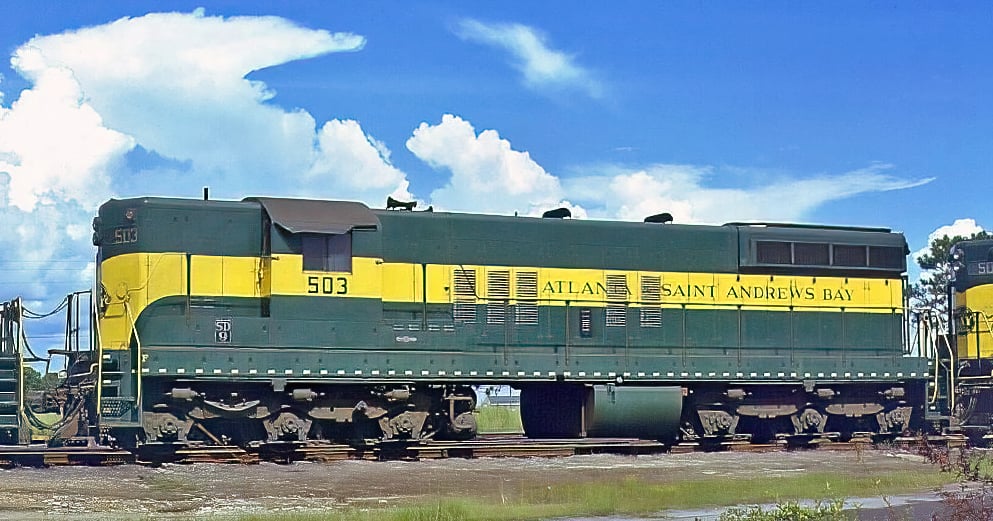
Atlanta & Saint Andrews Bay SD7 503 is about as “plain vanilla” as they come. (But vanilla is actually a rather complex flavor, so why does it so often get denigrated this way? After all, there 171 identified aromatic components in the vanilla fruit!) ASAB 503 features the SD9’s signature spotting feature: Classification lights above the numberboards on the hood ends’ outer edges. It also has a single fuel tank, no dynamic brakes and no excessive lighting (as found on Southern Pacific’s SD9s, although those lights are what make the SP units so popular). Note, however, that as with other SD9s, the stepwells are not the “switcher” type but rather the style found on road diesels. This unit operates short-hood forward, and along with spark arrestors on its exhaust stacks, it also has a rerail frog mounted on its lead truck. Panama City, Florida – August 1973.
Warren Calloway photograph
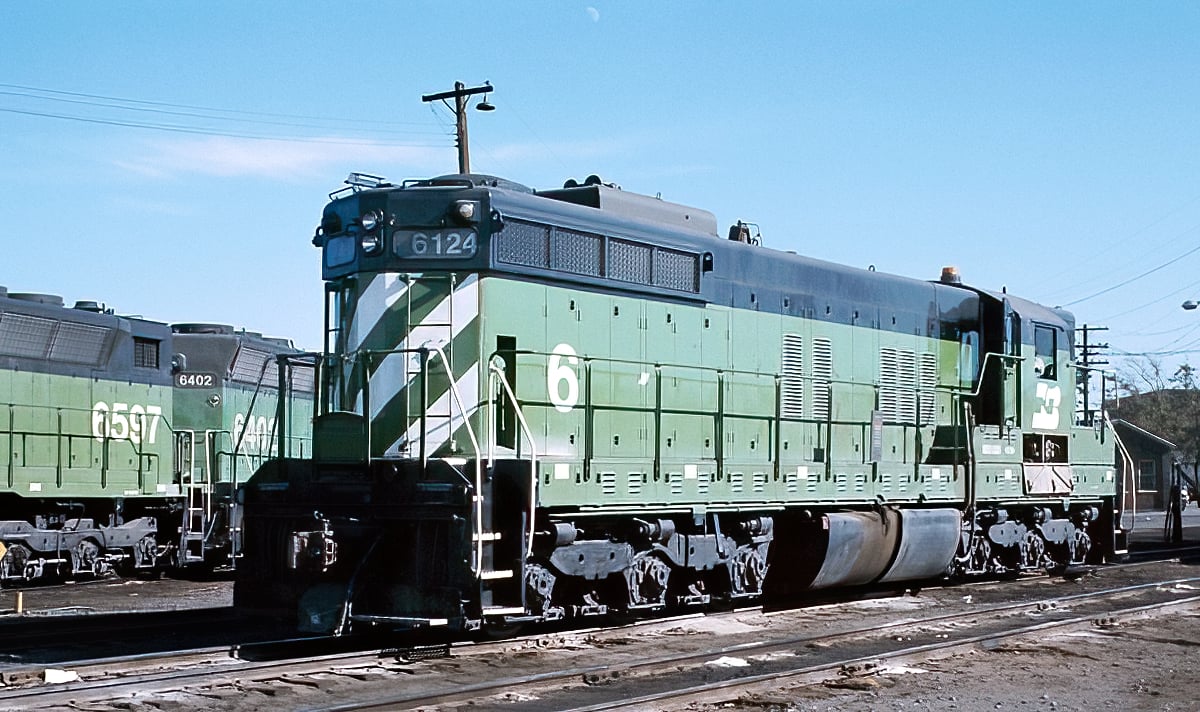
Stripe on the end of the long hood? Yup … This is a front view! Burlington Northern SD9 “6” (actually, of course, 6124, originally Great Northern 597) is a late-phase SD9, as is obvious from the two 48” radiator fans (admittedly, one is covered by the winterization hatch, so it isn’t that obvious) rather than four 36” fans. And these are the early fans with a curved top. Clearly not all GN diesels had dynamic braking, as this one does not. But it does, now as a BN unit, have a beacon on the cab roof, a bell on the center of the long-hood and an air horn on the winterization hatch, along with two fuel tanks. And what’s up with the mounting of the Sinclair radio antenna on the end of the long-hood? (Pasco, Washington – August 25, 1974)
Ron Hawkins photograph
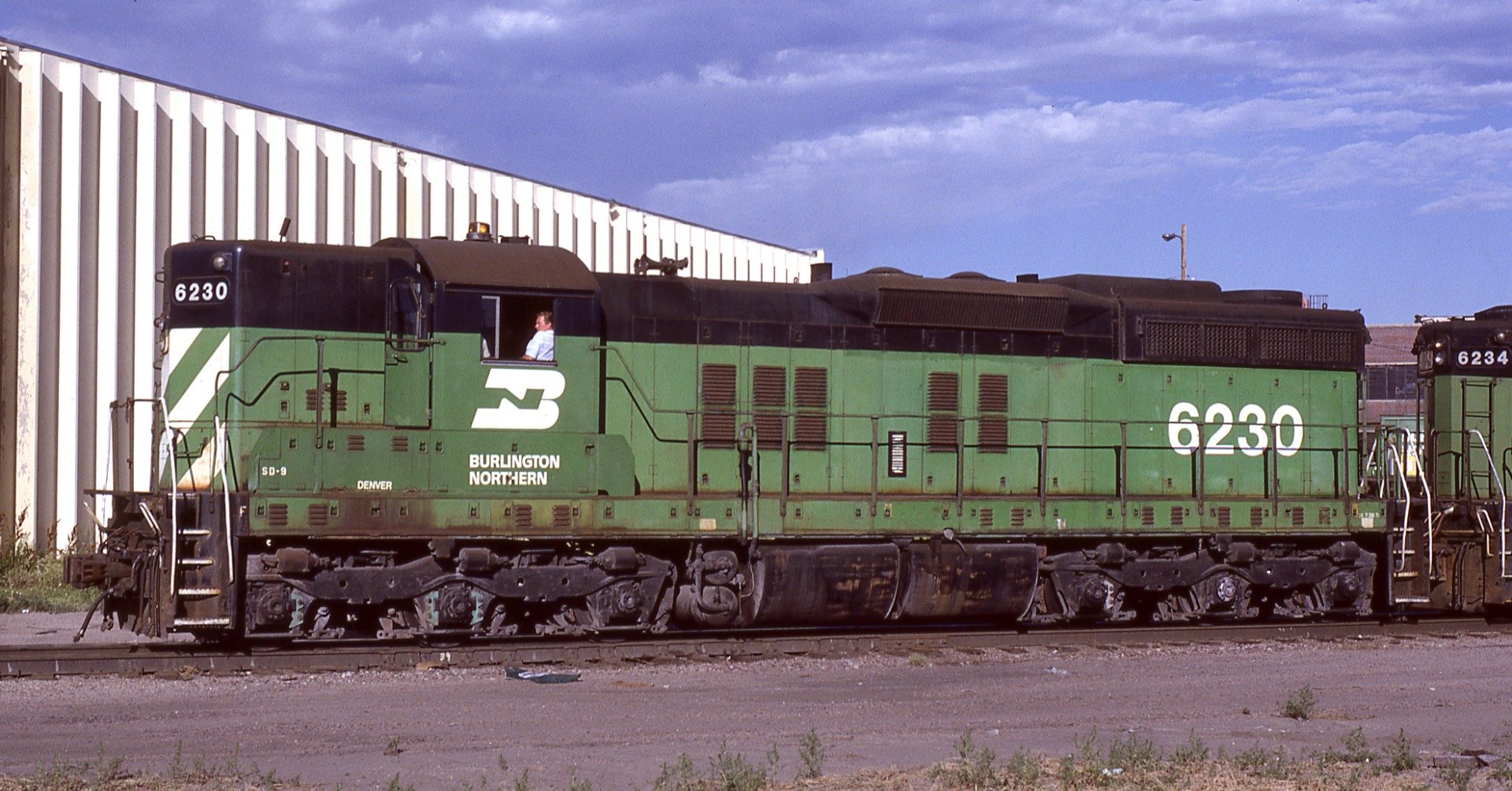
Burlington Northern SD9 6230 (ex-Chicago Burlington & Quincy subsidiary Colorado & Southern 6230, née-C&S 835) illustrates yet another variation of the late-phase SD9s. Along with the paired 48” radiator fans (again with one covered by a winterization hatch, but note that the visible one is now the later-style flat-top fan), the other spotting feature on these late (April 1959 in this case) SD9s is the short-hood that is taller than the long-hood! And on this locomotive, unlike BN 6124, the short-hood end is the front end, and it features dynamic braking. Note how low the headlight is mounted. This is as a result of BN removing the Pyle-National Gyralights (à la Southern Pacific) that used to be on the hood ends. (Denver, Colorado – July 1991)
Warren Calloway photograph
EMD Never Built an SD10 … But Milwaukee Road Did!
From March 1974 through December 1975, the perennially penniless Milwaukee Road rebuilt seventeen SD7s and four SD9s from their fleet into “SD10” locomotives. Because of these locomotives’ single small fuel tank and six-axle trucks, these were ideal for use on the railroad’s many branchlines or in transfer service, and were assigned to various points across the system from Chicago IL to Seattle WA. The high short hood was chopped (as were its ladders), the cab was rebuilt (adding a windshield and numberboards to the existing cab, except for MILW 555 which was rebuilt with a “GP35”-type angled-roof cab) and a beacon was added to the cab roof. Air reservoirs were changed from a vertical arrangement to a horizonal mounting. A Horst air filter was also added to the long hood (on 532, 534 and 543-555), or a Farr air filter (on 556-561). The exhaust stacks were modified to four (rather than the original two). The hood doors were also modified, as were the corner steps (to make each more “crew friendly). To help with winter weather, a snowplow was installed on the front pilot if the locomotive was not already so equipped. All SD10s were equipped with 1,200-gallon fuel tanks and winterization hatches. The rear class light position is unchanged – Centered over the numberboards on former SD7s, and outboard over the numberboards on former SD9s.
On February 19, 1985, all 21 SD10s were included among the MILW diesels transferred to the Soo Line.
Here is a roster of the SD10s:
- MILW 532 – (ex-MILW SD9 510, ex-MILW 541, née-MILW 2235) – to SOO 532
- MILW 534 – (ex-MILW SD7 509, née-MILW 2209) – to SOO 534, to CP 534
- MILW 543 – (ex-MILW SD7 520, née-MILW 2220) – to SOO 543
- MILW 544 – (ex-MILW SD7 523, née-MILW 2223) – to SOO 544, to DME 544
- MILW 545 – (ex-MILW SD7 521, née-MILW 2221) – to SOO 545, DME 545, INRD 545, INRD 2000, DLCX 2000
- MILW 546 – (ex-MILW SD7 504, née-MILW 2204) – to DME 546
- MILW 547 – (ex-MILW SD7 507, née-MILW 2207) – to SOO 547, to DME 547
- MILW 548 – (ex-MILW SD7 503, née-MILW 2203) – to SOO 548, to DME 548
- MILW 549 – (ex-MILW SD7 510, née-MILW 2210) – to DME 549
- MILW 550 – (ex-MILW SD7 517, née-MILW 2217) – to DME 550, to INRD 550, to Salt Lake Rail Services 550, to Terminal Switching Services 550, to SSRX 550
- MILW 551 – (ex-MILW SD9 534, née-MILW 2228) – to DME 551, to CHS/Northern Plains Co-Op at Selby SD
- MILW 552 – (ex-MILW SD7 506, née-MILW 2206) – to DME 552
- MILW 553 – (ex-MILW SD7 505, née-MILW 2205) – to DME 553
- MILW 554 – (ex-MILW SD9 535, née-MILW 2229) – to DME 554, to INRD 554; to Salt Lake Rail Services 554, to Terminal Switching Services 554, to SSRX 554, to Columbia Grain 554
- MILW 555 – (ex-MILW SD7 511, née-MILW 2211) – to DME 555, to INRD 555
- MILW 556 – (ex-MILW SD7 502, née-MILW 2202) – to DME 556
- MILW 557 – (ex-MILW SD9 536, née-MILW 2230) – to DME 557
- MILW 558 – (ex-MILW SD7 508, née-MILW 2208) – to DME 558, to INRD 558
- MILW 559 – (ex-MILW SD7 500, née-MILW 2200) – to DME 559, to INRD 559, INRD 2001
- MILW 560 – (ex-MILW SD7 514, née-MILW 2214) – to SOO 560, DME 560, to INRD 560
- MILW 561 – (ex-MILW SD7 516, née-MILW 2216) – wrecked at Marquette IA 1986, scrapped by SOO 6/88
Railroad reporting marks referenced above:
- CP – Canadian Pacific
- DLCX – Diesel Locomotive Company
- DME – Dakota Minnesota & Eastern
- DSRC – Dakota Southern Railway
- INRD – Indiana Railroad
- MILW – Chicago, Milwaukee, St Paul & Pacific (Milwaukee Road)
- SOO – Soo Line Railroad
- SSRX – S&S Shortline Leasing
For those keeping track, this is the first time a model of an SD10 has ever been produced in plastic! You’re welcome!
Thanks to Ron Hawkins, Rick Morgan and Gregory J. Sommers for their assistance!
